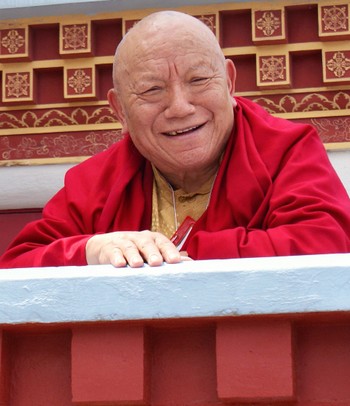
Chöje Lama Namse Rinpoche
Lama Dorje Sempa
Having presented the meditation instructions and the reading transmission so that disciples have the permission to meditate the Sadhana ("the sacred practice text"), I wish to speak a little about Dorje Sempa, Varjasattva in Sanskrit.
There are Dorje Sempa meditation instructions in both Sutra and Tantra, and Dorje Sempa I am referring to here is a tantric Terma ("hidden teaching") that was concealed by Guru Padmasambhava for later times and was revealed by great Tertöns ("treasure revealers") when disciples were ripe.
Dorje is the Tibetan term for Sanskrit vajra and means "indestructible diamond." Sempa is the Tibetan term for Sanskrit sattva and means "a heroic being," i.e., someone who exclusively works for the benefit and welfare of others. Dorje Sempa appears in two ways: the created image and the actual appearance of body, speech, and mind that manifests five enlightened Buddha activities in hundreds of ways. He manifests in a peaceful or in a forceful form, as a single deity or in myriad ways in order to help living beings. He manifests in a forceful form when he frees those beings suffering in the hell realms. For this reason, the 100-syllable mantra of Dorje Sempa has a peaceful and powerful aspect.
If one wishes to practice Buddhism, one needs to contemplate the four preliminary practices. The first contemplation is to appreciate ones precious human life. It's important to know why ones life is invaluable, and one does this by imagining being born in less favorable situations and under less fortunate circumstances, furthermore by thinking about how many lives one has had in the past, and by acknowledging the many opportunities one now has that make it possible to practice the Buddhadharma and to do good. The second preliminary practice is contemplating impermanence and death. Lord Buddha taught that all composite things are impermanent and therefore nothing lasts. The Buddha also taught that all blemished and tainted perceptions and apprehensions cause suffering. The impure way of seeing things is due to ignorance, i.e., not knowing how things are and how things appear. One becomes free from ignorance that brings on suffering by achieving enlightenment. Realizing fully that all appearances and apprehensions are empty of inherent existence and that all appearances and experiences merely arise in dependence upon many factors is the means to attain enlightenment, which is freedom from suffering. But one needs to purify ones mind of the stains that prevent one from realizing ones true nature, which is the pure Buddha nature.
The first step a disciple takes when aspiring to purify his or her mind from perceiving and apprehending impurely is taking refuge in the Three Jewels - the Buddha, Dharma, and Sangha. The Buddha is the ultimate refuge because he achieved and showed the way to enlightenment. The Dharma is all the teachings he offered that one is free to practice and integrate in ones life, and the Sangha is the community of practitioners who escort and support one along the way. Having taken refuge in the Three Jewels and having contemplated the four preliminary practices, a disciple then meditates Dorje Sempa and recites his mantra with one-pointed concentration in order to purify all negative karma amassed in this life as well as in all past lives. It is said that a practitioner becomes a noble Bodhisattva by purifying his or her mind of blemishes and impurities.
Appearing clearly - intangible like a reflection on the surface of a crystal-clear mirror - Dorje Sempa appears in ones imagination brilliantly white in color and dressed in multi-colored silk garments. Light radiates from the 100-syllable mantra in his heart to all wisdom deities, invoking them to come. They melt into him and into one through him, cleansing one of thoughts and the destructive emotions that are caused by ones thoughts, as well as of sicknesses, and obstacles. Having been cleansed, one recites his 100-syllable mantra while abiding in one-pointed concentration. One can recite the manta 100 or 1000 times or more often and purify ones negative karma. If one recites the mantra 100,000 times, then one will have purified negative karma one has created in 100 or 200 past lives. There are various kinds of negative actions, for instance, the immeasurable evil deeds that are killing a Lama or parricide. By meditating Dorje Sempa and by reciting his mantra with the correct motivation, one will become free from experiencing the painful results of the negative actions one has done.
In order to give rise to the wish to cleanse ones negative karma, one needs four strengths. They are recognizing that a deed one committed is negative and regretting it. The second strength is applying a remedy and resolving not to repeat a negative action or actions but to engage in wholesome activities instead, which is the third strength. The fourth strength is trusting that one will achieve enlightenment and that one will be able to help living beings by meditating Dorje Sempa, who represents all Vajrayana deities as well as our Lineage Lamas.
Buddhists texts state that one will become free from samsara if one cultivates the four strengths. There is the story of an incident that took place during the times of Lord Buddha to illustrate this. There was a Brahmin who killed many people, cut off a finger from each victim, and made a long necklace out of their fingers. He regretted his actions, sought Lord Buddha's advice, practiced the teachings, and achieved the state of an Arhat, the Sanskrit term for "foe destroyer," foe being delusive thoughts and destructive emotions and the actions one carries out based upon them.
Having meditated Dorje Sempa and cleansed oneself of negativities, one prays to him and promises not to break ones commitment again. But it does happen and is natural to break ones commitment, so one prays to him for his support. Then one feels that one is united with him and rests in that state for a while.
Signs appear while fervently and regularly engaging in practices like this, for instance, one might dream of bloody and filthy scenes. One should not be frightened when one has such dreams, because they are signs of the purification process. One might dream that ones body and mind are very light, which is also a sign that ones practice is going well. One might also dream of visiting a Lama and conversing nicely, which is also a good sign. One can also dream about karma, attaining certainty of karma, which is also a good sign. But one needn't worry if one doesn't dream. If one dreams, fine; if not, fine too. One shouldn't have any expectations.
In Buddhist practice one should not be fanatic or too easy-going. If a musician plays his violin frantically, then he will not play well; if he plays his violin too carefree, then he will not play well either. In the same manner, one needs to practice not too tightly and not too loosely, rather in a well-balanced manner.
After having received the reading transmission that empowers one to practice the Sadhana of Dorje Sempa, it's important to recite the dedication prayers. Thank you very much.
Dedication
Through this goodness may omniscience be attained
And thereby may every enemy (mental defilement) be overcome.
May beings be liberated from the ocean of samsara
That is troubled by waves of birth, old age, sickness, and death.
By this virtue may I quickly attain the state of Guru Buddha and then
Lead every being without exception to that very state!
May precious and supreme Bodhicitta that has not been generated now be so,
And may precious Bodhicitta that has already been never decline, but continuously increase!
May the life of the Glorious Lama remain steadfast and firm.
May peace and happiness fully arise for beings as limitless in number as space is vast in its extent.
Having accumulated merit and purified negativities,
May I and all living beings without exception swiftly establish the levels and grounds of Buddhahood.
Presented at Karma Chang Chub Choephel Ling in Heidelberg in 2005. In reliance on the German translation of the Tibetan, translated into English and edited by Gaby Hollmann, with sincere gratitude to Hans Billing for making the recording available to us and for all his unfailing endeavours to maintain the website of the center. May goodliness and truthfulness increase!















